History
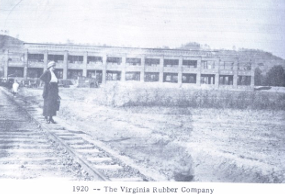 Several hundred people were employed by the Virginia Rubber and Tire Company in Saint Albans, West Virginia, on January 13, 1924. The business, located on 41 acres of land along the Kanawha River across from the present-day Ordnance Park (ca. 1941)…and before MacCorkle Avenue, was thriving in 1924. Established in 1920, it was only four years old. Unfortunately, the Virginia Rubber and Tire Company, was destined not to reach it’s fifth year. That fateful January day in 1924, brought with it a fire that destroyed the company, causing damage totaling $500,000.
Several hundred people were employed by the Virginia Rubber and Tire Company in Saint Albans, West Virginia, on January 13, 1924. The business, located on 41 acres of land along the Kanawha River across from the present-day Ordnance Park (ca. 1941)…and before MacCorkle Avenue, was thriving in 1924. Established in 1920, it was only four years old. Unfortunately, the Virginia Rubber and Tire Company, was destined not to reach it’s fifth year. That fateful January day in 1924, brought with it a fire that destroyed the company, causing damage totaling $500,000.
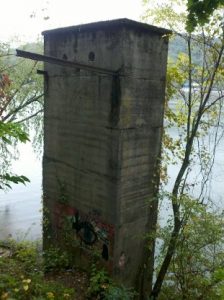
While I was unable to find much information as to the time and cause of the fire, it is noted that only about 10 percent of the tire stock was saved, and the rest was burned. That isn’t really surprising, since rubber tires are highly flammable. Unfortunately, it also doesn’t appear that all of the loss was covered by the company’s insurance. As an insurance agent, I can say that a property loss that was not completely covered by insurance could only mean that the company was underinsured, leaving gaps in the coverage. What is known about the loss is that the unpaid portion was enough to ensure that the company could never open their doors again. That meant that several hundred people were out of a job, and while they didn’t know it, the Great Depression was coming up quickly. I’m sure they all had jobs before that time, but it was quite likely that they would lose their jobs when that 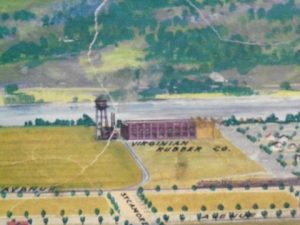 time came.
time came.
The good news about the fire was that it took no lives. The only loss was to the property. Nevertheless, the town would never be quite the same again. Other businesses would grow up where the rubber company had once been, but mostly it would be remembered as the site of Morgan’s Plantation Kitchen, originally established in 1846. I supposed the site went back to it’s former identity. Still, the total loss of the Virginia Rubber and Tire Company, manufacturer of tires, tubes, toy balloons, balls, and rubber dolls, would not be forgotten.
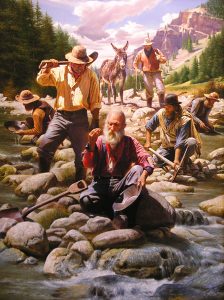 After the discovery of gold in California, people went crazy…mad really for gold. For twenty years, in fact, all the West was mad for gold. People packed up their lives, and headed west, hoping to dig their fortune out of the California dirt. At first, the people heading west were mostly men, but there were families that went too. It didn’t really matter who it was, when it came to gold, people were willing to fight to the death for what was theirs, or for what they wanted. Greed was the word of the day, and it was a disease that everyone in California had.
After the discovery of gold in California, people went crazy…mad really for gold. For twenty years, in fact, all the West was mad for gold. People packed up their lives, and headed west, hoping to dig their fortune out of the California dirt. At first, the people heading west were mostly men, but there were families that went too. It didn’t really matter who it was, when it came to gold, people were willing to fight to the death for what was theirs, or for what they wanted. Greed was the word of the day, and it was a disease that everyone in California had.
The Gold Rush brought honest citizens and outlaws alike to California. People had to be on guard at all times. If someone struck gold, they were an immediate target for anyone willing to steal their gold, or even to kill for it. The mad rush for gold soon spread to other areas of the United States. The gold-hunters, no longer content with California, began to prospect lower Oregon, upper Idaho, and Western Montana too. They figured that if one place had gold, why wouldn’t another place have it too. And with the slightest discovery, came the craziness of Gold Dust Fever.
With Gold Fever came the sinister figure of the trained desperado, the professional bad man. The business of 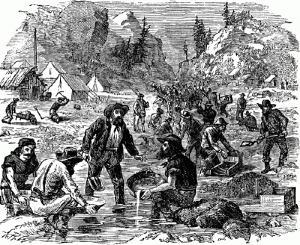 being an outlaw was turned into one highly organized profession that was relatively safe and extremely lucrative. There was wealth to be had for the asking or the taking, and these men, and sometimes women, were willing. Each miner had his buckskin purse filled with native gold. This dust was like all other dust. It could not be traced nor identified; and the old saying, ”’Twas mine, ’tis his,” might here of all places in the world most easily become true. There were no checks, drafts, or currency, as we know it now. The normal means by which civilized men keep a record of their property transactions, were unknown. The gold scales established the only currency, and each man was his own banker, obliged to be his own peace officer and the defender of his own property. It was a wild world. It was a world mad for gold.
being an outlaw was turned into one highly organized profession that was relatively safe and extremely lucrative. There was wealth to be had for the asking or the taking, and these men, and sometimes women, were willing. Each miner had his buckskin purse filled with native gold. This dust was like all other dust. It could not be traced nor identified; and the old saying, ”’Twas mine, ’tis his,” might here of all places in the world most easily become true. There were no checks, drafts, or currency, as we know it now. The normal means by which civilized men keep a record of their property transactions, were unknown. The gold scales established the only currency, and each man was his own banker, obliged to be his own peace officer and the defender of his own property. It was a wild world. It was a world mad for gold.
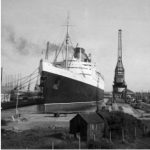 One of the most elegant ships ever built, RMS Queen Elizabeth, was one of the two superliners built by John Brown and Company in Clydebank, Scotland, in the 1930s. The ship did not start out as RMS Queen Elizabeth, but rather as Hull 552. Later, it was named in honor of Queen Elizabeth, and launched, on 27 September 1938. The RMS Queen Elizabeth was 1,031 feet long and 118.5 feet wide. It was the largest passenger liner ever constructed…until then anyway.
One of the most elegant ships ever built, RMS Queen Elizabeth, was one of the two superliners built by John Brown and Company in Clydebank, Scotland, in the 1930s. The ship did not start out as RMS Queen Elizabeth, but rather as Hull 552. Later, it was named in honor of Queen Elizabeth, and launched, on 27 September 1938. The RMS Queen Elizabeth was 1,031 feet long and 118.5 feet wide. It was the largest passenger liner ever constructed…until then anyway.
During the late 1930s, workers at a Scottish construction site began building a sea vessel for the Cunard Line ocean liner company that would be larger and more luxurious than anything the world had ever seen. However, the outbreak of World War II in 1939 prevented the completion of the Queen Elizabeth‘s finer points. The vessel was hastily made seaworthy for wartime service and was used as a transport vessel for the Allies, carrying massive amounts of supplies and several hundred thousand troops around the world until the war’s end. Because of the concerns over German bombing, the ship was moved to New York to harbor it in a safer place.
After the war, the ship, which was equipped with a 200,000 horsepower engine, was embellished with an elegant art deco style. It made its public debut in 1946, leaving Southampton, England, on its first luxurious 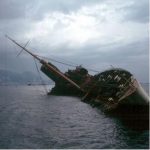 run across the Atlantic. The ship continued to be a luxury passenger liner until it retirement in 1968.
run across the Atlantic. The ship continued to be a luxury passenger liner until it retirement in 1968.
Then, the Queen Elizabeth was auctioned off to the highest bidder, eventually being purchased in 1970 by C.W. Tung, a Taiwanese shipping tycoon. Tung renamed the vessel Seawise University and began work on converting the ship into a learning center that would tour the world. However, in early 1972, as the mobile university neared completion, a fire destroyed the pride of the Cunard Line. The fire broke out while the ship was docked in Hong Kong Harbor, and by the next morning the famous vessel was a total loss on the bottom of the sea floor.
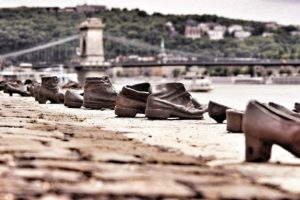 While looking at some historic photos, I came across one that was both intriguing, and sad. The title of the photograph was as intriguing as the photograph itself. Shoes on the Danube Banksdepicts a memorial in Budapest, Hungary that was conceived by film director Can Togay. The memorial sits on the east and of the Danube River. Togay worked with sculptor Gyula Pauer to create a memorial to honor the Jews who were killed by fascist Arrow Cross militiamen in Budapest during World War II.
While looking at some historic photos, I came across one that was both intriguing, and sad. The title of the photograph was as intriguing as the photograph itself. Shoes on the Danube Banksdepicts a memorial in Budapest, Hungary that was conceived by film director Can Togay. The memorial sits on the east and of the Danube River. Togay worked with sculptor Gyula Pauer to create a memorial to honor the Jews who were killed by fascist Arrow Cross militiamen in Budapest during World War II.
As I looked at the picture of many pairs of shoes, the magnitude of what had happened there, and exactly what I was looking at hit me. These shoes were not just shoes, they were people…innocent people, who lined up and shot for no other reason than that they were Jewish. These people were told to remove their shoes, and then they were shot. Their lifeless bodies fell into the river and were swept downstream. There was no funeral, no burial…despite the traditions that are set up for Jewish burial. Of course, I know that not every Jewish death can be handles in the Jewish traditions, but these people were murdered in such a way as to humiliate them, including the lack of a traditional burial.
The monument along the Danube River represents the lives of the people who were murdered, there is no way to really represent the people, because no one knows who they were, what they looked like, or even how many there were for sure, but rather the monument depicts their shoes left behind on the bank. It is the only real connection we can have to these victims of such horrible hatred. The brutal treatment of the approximately 3,500 people, 800 of them Jews, and the rest accused of Jewish activities, is beyond horrid. These people were forced to strip naked on the banks of the Danube and face the river. Then, a firing squad shot the prisoners at close range in the back so that they fell into the river to be washed away.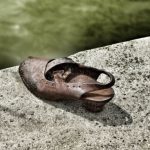
The monument is located on the Pest side of the Danube Promenade in line with where Zoltan Street would meet the Danube if it continued that far, about 980 feet south of the Hungarian Parliament and near the Hungarian Academy of Sciences…between Roosevelt Square and Kossuth square. The sculptor created sixty pairs of period-appropriate shoes out of iron. The shoes are attached to the stone embankment, and behind them lies a 131 foot long, 27 inch high stone bench. At three points are cast iron signs, with the following text in Hungarian, English, and Hebrew: “To the memory of the victims shot into the Danube by Arrow Cross militiamen in 1944–45. Erected 16 April 2005.”
Most of the murders along the edge of the River Danube took place around December 1944 and January 1945, when the members of the Arrow Cross Party police (“Nyilas”) took as many as 20,000 Jews from the newly established Budapest ghetto and executed them along the river bank. There were, of course, some survivors who managed to make it out, and lived to tell their stories. On of those Was Tommy Dick, who wrote the book, “Getting Out Alive.” I have not read the book yet, but after seeing this memorial, I will be reading it very soon.
There were heroes in Budapest too. Valdemar Langlet, head of the Swedish Red Cross in Budapest, with his wife Nina, and later the diplomat Raoul Wallenberg and 250 coworkers were working around the clock to save the Jewish population from being sent to Nazi concentration camps. This group later grew in number to approximately 400. Lars and Edith Ernster, Jacob Steiner, and many others were housed at the Swedish Embassy in Budapest and 32 other buildings throughout the city which Wallenberg had rented and declared as extraterritorially Swedish to try to safeguard the residents. Italian Giorgio Perlasca did the same, sheltering Jews in the Spanish Embassy.
On the night of January 8, 1945, an Arrow Cross execution brigade forced all the inhabitants of the building on 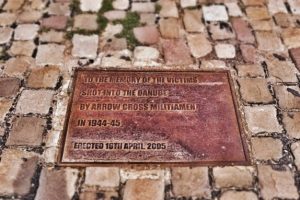 Vadasz Street to the banks of the Danube. At midnight, Karoly Szabo and 20 policemen with drawn bayonets broke into the Arrow Cross house and rescued everyone. Among those saved were Lars Ernster, who fled to Sweden and became a member of the board of the Nobel Foundation from 1977 to 1988, and Jacob Steiner, who fled to Israel and became a professor at the Hebrew University of Jerusalem. Steiner’s father had been shot dead by Arrow Cross militiamen 25 December 1944, and fell into the Danube. His father had been an officer in World War I and spent four years as a prisoner of war in Russia. These were horrific murders, and after looking at the pictures of this memorial and reading about the horrible murders, my mind cannot unsee the images it has conjured up of this atrocity.
Vadasz Street to the banks of the Danube. At midnight, Karoly Szabo and 20 policemen with drawn bayonets broke into the Arrow Cross house and rescued everyone. Among those saved were Lars Ernster, who fled to Sweden and became a member of the board of the Nobel Foundation from 1977 to 1988, and Jacob Steiner, who fled to Israel and became a professor at the Hebrew University of Jerusalem. Steiner’s father had been shot dead by Arrow Cross militiamen 25 December 1944, and fell into the Danube. His father had been an officer in World War I and spent four years as a prisoner of war in Russia. These were horrific murders, and after looking at the pictures of this memorial and reading about the horrible murders, my mind cannot unsee the images it has conjured up of this atrocity.
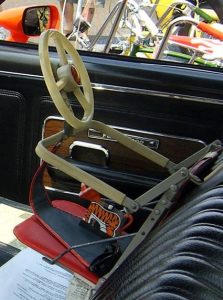 As long has there have been road trips with children, there have been bored children, asking, “When do we get there?” They don’t understand that one of the best parts of a road trip is the time spent on the road. The destination is the end of the adventure, not necessarily the adventure itself. Invariably, after the ten time that those precious little ones ask that dreaded question, tempers begin to flare. These days, cars come with built in DVD players to occupy the kids on the road trip, but back when I was a kid, those things didn’t exist.
As long has there have been road trips with children, there have been bored children, asking, “When do we get there?” They don’t understand that one of the best parts of a road trip is the time spent on the road. The destination is the end of the adventure, not necessarily the adventure itself. Invariably, after the ten time that those precious little ones ask that dreaded question, tempers begin to flare. These days, cars come with built in DVD players to occupy the kids on the road trip, but back when I was a kid, those things didn’t exist.
Somewhere along the way, someone…probably a frustrated parent…came up with the idea of allowing the kids to participate in the trip by giving them a steering wheel of their own, so they could help their parents drive. I do know that in January of 1955, a  man named Jack Fletcher of West Covina, California installed a plastic windshield and three miniature steering wheels in the back seat of his car to entertain his children, Janie, Johnny and Ricky, who were 3 years, 21 months, and 21 months respectively. Apparently, it was a good idea, at least for those children, because, the idea has hung around ever since. In fact, for Christmas, we got our great granddaughter a version that can sit on the floor in front of her, or even on her highchair tray. Now she can “help” her daddy drive too. As children get older, I’m sure that the novelty of a steering wheel wore off, but if you
man named Jack Fletcher of West Covina, California installed a plastic windshield and three miniature steering wheels in the back seat of his car to entertain his children, Janie, Johnny and Ricky, who were 3 years, 21 months, and 21 months respectively. Apparently, it was a good idea, at least for those children, because, the idea has hung around ever since. In fact, for Christmas, we got our great granddaughter a version that can sit on the floor in front of her, or even on her highchair tray. Now she can “help” her daddy drive too. As children get older, I’m sure that the novelty of a steering wheel wore off, but if you  got a year or so of peace in the car, it’s worth the effort.
got a year or so of peace in the car, it’s worth the effort.
Of course, when I was a kid, there were mo car seats, and it wasn’t illegal to drive with your child on your lap. Many a child, me and my sisters included, learned to steer the car while seated on our daddy’s lap. It was great fun, and a memory we will always have. I suppose that today’s drivers, police officers, and child safety advocates would cringe at the thought of a child on the lap of the driver, and maybe it wasn’t the safest way to do things, but I don’t recall hearing about dozens of children dying in that manner either, so maybe the parents of yesteryear weren’t so careless after all. All I know, is that we had a great time on those road trips.
 Earthquakes can happen anywhere, but there are areas that are more prone to earthquakes than other areas. When we think about that, we think of Alaska, California, or Japan, all of which experience daily earthquakes. Of course, there are many other places that get a lot of earthquakes. One such place is in Italy. The area around Sicily and Calabria are known as la terra ballerina, “the dancing land,” for the periodic seismic activity that strikes the region. I would have thought that with 12,000 earthquakes a year in Alaska, or 10,000 earthquakes a year in California, or 1,500 earthquakes in Japan, that any of these places would be called “the dancing land” before the area of Sicily and Calabria, which doesn’t have nearly as many.
Earthquakes can happen anywhere, but there are areas that are more prone to earthquakes than other areas. When we think about that, we think of Alaska, California, or Japan, all of which experience daily earthquakes. Of course, there are many other places that get a lot of earthquakes. One such place is in Italy. The area around Sicily and Calabria are known as la terra ballerina, “the dancing land,” for the periodic seismic activity that strikes the region. I would have thought that with 12,000 earthquakes a year in Alaska, or 10,000 earthquakes a year in California, or 1,500 earthquakes in Japan, that any of these places would be called “the dancing land” before the area of Sicily and Calabria, which doesn’t have nearly as many.
Nevertheless, the name was given and it stuck. While it may not have as many, the ones that hit there seem to be especially devastating. In 1693, 60,000 people were killed in southern Sicily by an earthquake, and in 1783 most of the Tyrrenian coast of Calabria was leveled by a massive earthquake that 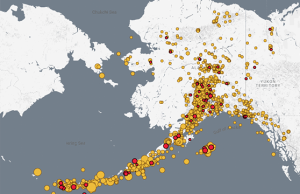 killed 50,000. The quake of 1908 was particularly costly in terms of human life because it struck at at dawn, catching most people at home in bed rather than in the relative safety of the streets or fields. The December 28, 1908 earthquake which struck at 5:20am was the most destructive earthquake in recorded European history strikes the Straits of Messina in southern Italy. The cities of Messina in Sicily and Reggio di Calabria on the Italian mainland were leveled by the devastating quake. The earthquake and tsunami it caused killed an estimated 100,000 people. The main shock registered an estimated 7.5 magnitude on the Richter scale. It caused a devastating tsunami with 40-foot waves that washed over coastal towns and cities. The two major cities on either side of the Messina Straits–Messina and Reggio di Calabria, had about 90 percent of their buildings destroyed. The quake cut telegraph lines and damaged railway lines, seriously slowing down the relief efforts. To make matters worse, many of the remaining buildings were destroyed by hundreds of smaller
killed 50,000. The quake of 1908 was particularly costly in terms of human life because it struck at at dawn, catching most people at home in bed rather than in the relative safety of the streets or fields. The December 28, 1908 earthquake which struck at 5:20am was the most destructive earthquake in recorded European history strikes the Straits of Messina in southern Italy. The cities of Messina in Sicily and Reggio di Calabria on the Italian mainland were leveled by the devastating quake. The earthquake and tsunami it caused killed an estimated 100,000 people. The main shock registered an estimated 7.5 magnitude on the Richter scale. It caused a devastating tsunami with 40-foot waves that washed over coastal towns and cities. The two major cities on either side of the Messina Straits–Messina and Reggio di Calabria, had about 90 percent of their buildings destroyed. The quake cut telegraph lines and damaged railway lines, seriously slowing down the relief efforts. To make matters worse, many of the remaining buildings were destroyed by hundreds of smaller 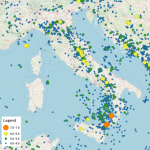 tremors over subsequent days. These tremors injured or killed rescuers. On December 30, King Victor Emmanuel III arrived aboard the battleship Napoli to inspect the devastation.
tremors over subsequent days. These tremors injured or killed rescuers. On December 30, King Victor Emmanuel III arrived aboard the battleship Napoli to inspect the devastation.
To make matters worse, a steady rain fell on the ruined cities, forcing the dazed and injured survivors, clad only in their nightclothes, to take shelter in caves, grottoes, and impromptu shacks built out of materials salvaged from the collapsed buildings. Veteran sailors could barely recognize the shoreline because long stretches of the coast had sunk several feet into the Messina Strait. The devastation was horrific. After all that, I can see why it is called la terra ballerina, “the dancing land.”
 There is a tradition in England and a few other nations like Canada and Ireland, that takes place the day after Christmas, called Boxing Day. It is an odd name for a holiday, but I think the purpose of the holiday far outweighs the name of the holiday. People might argue the original purpose of the holiday, but the most straightforward answer as to what it is about would be that, “We are a little greedy here in the England and Ireland in wanting a more extended holiday. It is not enough for us to have only Christmas Day celebrations, we have added to this another event called Boxing Day.” That might be one part of the picture, but the full answer is not that simple. But firstly, it has nothing to do with the sport of boxing.
There is a tradition in England and a few other nations like Canada and Ireland, that takes place the day after Christmas, called Boxing Day. It is an odd name for a holiday, but I think the purpose of the holiday far outweighs the name of the holiday. People might argue the original purpose of the holiday, but the most straightforward answer as to what it is about would be that, “We are a little greedy here in the England and Ireland in wanting a more extended holiday. It is not enough for us to have only Christmas Day celebrations, we have added to this another event called Boxing Day.” That might be one part of the picture, but the full answer is not that simple. But firstly, it has nothing to do with the sport of boxing.
Boxing Day is a national Bank Holiday. It is a day to spend with family and friends and to eat up all the leftovers of Christmas Day, but there is more to it than that. The origins of the day are filled with history and tradition. People have long disputed the origins of the name Boxing Day. The name is actually a reference to holiday gifts. A “Christmas Box” in Britain is a name for a Christmas present. Boxing Day was traditionally a day off for the servants and the day when they received a “Christmas Box” from the master. The servants would also go home on Boxing Day to give “Christmas Boxes” to their families.
Traditionally, a box to collect money for the poor was placed in churches on Christmas day. The boxes were  opened the next day…Boxing Day. The name refers to a nautical tradition. Great sailing ships when setting sail would have a sealed box containing money on board for good luck. Were the voyage a success, the box was given to a priest, opened at Christmas and the contents then given to the poor. Boxing Day is the 26th December is a national holiday in England and Ireland.
opened the next day…Boxing Day. The name refers to a nautical tradition. Great sailing ships when setting sail would have a sealed box containing money on board for good luck. Were the voyage a success, the box was given to a priest, opened at Christmas and the contents then given to the poor. Boxing Day is the 26th December is a national holiday in England and Ireland.
Boxing Day is a time to spend with family or friends, but usually not those seen on Christmas Day itself. In recent times, the day has begun to include many sports. Horse racing is particularly popular with meets all over the country. Many top football teams also play on Boxing Day. Boxing Day is a time when the British show their eccentric side by taking part in all kinds of silly activities. Bizarre traditions include swimming the icy cold English Channel, fun runs, and charity events. Until 2004, Boxing Day hunts were a traditional part of the day, but the ban on fox hunting has put an end to this in its usual sense. Hunters will still gather dressed resplendently in red hunting coats to the sound of the hunting horn. But, since it is now forbidden to chase the fox with dogs, they now follow artificially laid trails.
Another “sport” to emerge in recent years is shopping. Sadly, what was once a day of relaxation and family time sees the start of the sales. Sales used to start in January, post-New Year, but the desire to grab a bargain and for shops to off-load stock means many now begin on Boxing Day. This tradition makes me especially sad, because it is like Black Friday. By moving Black Friday shopping to Thanksgiving, and now post Christmas sales to Boxing Day, have soured many people to shopping on these days, and the whole purpose is defeated.

In Ireland, Boxing Day is also known as “Saint Stephen’s Day” named after the Saint stoned to death for believing in Jesus. In Ireland on Boxing, there was once a barbaric act carried out by the so-called “Wren Boys.” These boys would dress up and go out, and stone wren birds to death then carry their catch around the town knocking on doors and asking for money, the stoning representing what had happened to Saint Stephen. This terrible tradition has now stopped, thank goodness, but the Wrens Boys still dress up. Now, instead they parade around town and collect money for charity. I’m thankful that such a barbaric tradition, has now taken on a new look, and is now used for good.
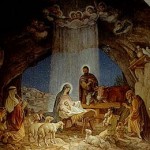 When most people think of Christmas, their minds think of Santa Clause, turkey dinners, and weeks of preparatory shopping, and yes those things are a part of Christmas for most people, but there is a far more important reason for the Christmas season…the birth of our Saviour, Jesus Christ, the Lord. Yes, I am aware that we don’t know the exact date of our Saviour’s birth, and many are quite certain that it was nowhere near December 25th, and in reality, not in winter. To most Christians, however, those minor details don’t matter, because we are talking about our Lord. It’s ok to celebrate Jesus anytime.
When most people think of Christmas, their minds think of Santa Clause, turkey dinners, and weeks of preparatory shopping, and yes those things are a part of Christmas for most people, but there is a far more important reason for the Christmas season…the birth of our Saviour, Jesus Christ, the Lord. Yes, I am aware that we don’t know the exact date of our Saviour’s birth, and many are quite certain that it was nowhere near December 25th, and in reality, not in winter. To most Christians, however, those minor details don’t matter, because we are talking about our Lord. It’s ok to celebrate Jesus anytime.
Most Christians think of gift giving as being symbolic of the greatest gift ever given…Jesus who came to earth to save us from our sin filled world by dying on the cross so that we would be able to go Heaven. Of course, no gift we could ever give could measure up to the gift Jesus gave us, but we can celebrate Jesus by having a giving spirit. After all, that is what Jesus was all about. I don’t mean presents, but rather the ultimate gift, the greatest love ever given…”For God so loved the world that He gave His only begotten Son, that whoever believes in Him should not perish but have everlasting life.” John 3:16. What great gift could there ever be than to give His life so that we could live, and what greater reason could there ever be to celebrate Jesus. The date error, if there is one, makes no difference…just God’s love.

Christmas means different things to different people, of course, but I think that the most important thing is to make sure that we don’t lose sight of the real reason for the season…the birth of the Saviour of the world. Before Jesus came,we had no hope. We were lost, and going to Hell. After Jesus lived, died, and rose again, everything changed and hope returned. For Christians, there is nothing more important. Jesus is our advocate with the Father. He is the the true meaning o grace. His git to us…salvation, was not something we could ever earn. we were lost and all hope was gone. Then Jesus was born, and we had a reason to celebrate again. Happy birthday Jesus, and Merry Christmas everyone.
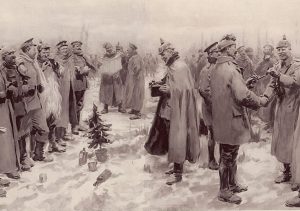 It was 1914, and World War I was in the 5th month of a 51 month offensive. The war effort was in a bit of a transition period, following the stalemate of the Race to the Sea and the indecisive result of the First Battle of Ypres. As leadership on both sides reconsidered their strategies, hostilities entered a bit of a lull. The men were hoping for a break in the action for Christmas that year, but they had to wait for their orders. When the orders came down, it was not to be a Christmas truce, but rather a Christmas strike. As the first men to go forth prepared to make the first advances, some men were killed, and some returned. It was the way of war. The leadership wanted to take advantage of the possibility that the enemy might not expect a Christmas attack. One of the younger men…17 years old to be exact, couldn’t help himself. He began to sing Silent Night.His superiors ordered it to be quiet. They feared that the enemy was waiting in the darkness.
It was 1914, and World War I was in the 5th month of a 51 month offensive. The war effort was in a bit of a transition period, following the stalemate of the Race to the Sea and the indecisive result of the First Battle of Ypres. As leadership on both sides reconsidered their strategies, hostilities entered a bit of a lull. The men were hoping for a break in the action for Christmas that year, but they had to wait for their orders. When the orders came down, it was not to be a Christmas truce, but rather a Christmas strike. As the first men to go forth prepared to make the first advances, some men were killed, and some returned. It was the way of war. The leadership wanted to take advantage of the possibility that the enemy might not expect a Christmas attack. One of the younger men…17 years old to be exact, couldn’t help himself. He began to sing Silent Night.His superiors ordered it to be quiet. They feared that the enemy was waiting in the darkness.
Then, a miracle occurred. In the week leading up to the 25th of December, French, German, and British soldiers crossed trenches to exchange seasonal greetings…and to talk. In some areas, men from both sides ventured into what was called no man’s land, because to go there was to risk death. Nevertheless, on that Christmas Eve and Christmas Day, things seemed different. The soldiers took a chance and stepped forward, hoping to convince their enemies that they only wanted to bury their dead, and hoping that it would be  agreeable to stop the fighting for one hour to bury the dead. As they buried their dead, with heavy hearts, someone suggested that they take Christmas Day off. This was totally against their orders, and they knew that at some point they were going to have to go back and follow their orders. They were going to have to become enemies again. Still, for now…for this day, they mingled and exchange food and souvenirs. There were joint burial ceremonies and prisoner swaps. Men played games of football with one another, giving one of the most memorable images of the truce. Peaceful behavior was not ubiquitous, however, and fighting continued in some sectors, while in others the sides settled on little more than arrangements to recover bodies. Several meetings ended in carol-singing. Someone commented, “How many times in a life do you actually meet your enemy face to face.” It was almost strange to them, because these “enemies” were not the monsters they expected them to be. These were simply men, just like they were. I’m sure the men were in shock. it’s hard to have your total view of your enemy change so drastically and then have to follow your orders, pickup your weapons, and shoot at the same men again. The Christmas truce (German: Weihnachtsfrieden; French: Trêve de Noël) was a series of widespread but unofficial ceasefires along the Western Front of World War I around Christmas 1914.
agreeable to stop the fighting for one hour to bury the dead. As they buried their dead, with heavy hearts, someone suggested that they take Christmas Day off. This was totally against their orders, and they knew that at some point they were going to have to go back and follow their orders. They were going to have to become enemies again. Still, for now…for this day, they mingled and exchange food and souvenirs. There were joint burial ceremonies and prisoner swaps. Men played games of football with one another, giving one of the most memorable images of the truce. Peaceful behavior was not ubiquitous, however, and fighting continued in some sectors, while in others the sides settled on little more than arrangements to recover bodies. Several meetings ended in carol-singing. Someone commented, “How many times in a life do you actually meet your enemy face to face.” It was almost strange to them, because these “enemies” were not the monsters they expected them to be. These were simply men, just like they were. I’m sure the men were in shock. it’s hard to have your total view of your enemy change so drastically and then have to follow your orders, pickup your weapons, and shoot at the same men again. The Christmas truce (German: Weihnachtsfrieden; French: Trêve de Noël) was a series of widespread but unofficial ceasefires along the Western Front of World War I around Christmas 1914.
The Christmas Truces of 1914, while wonderful for the men, were not to be a Christmas tradition in World War I. The following year, a few units arranged ceasefires but the truces were not nearly as widespread as in 1914. 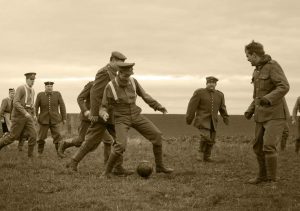 This was, in part, due to strongly worded orders from the high commands of both sides prohibiting truces. It was evident that while the mini-mutiny of 1914 was tolerated and the men were not punished, that this would not be tolerated in the future. It really didn’t matter, because the Soldiers were no longer amenable to truce by 1916. The war had become increasingly bitter after devastating human losses suffered during the battles of the Somme and Verdun, and the use of poison gas. While a Christmas truce would be nice in theory, bitter and angry feelings on both sides of a war make it an impractical idea. Still, in 1914, the miracle of the Christmas Truce was a wonderful treat for the men on all sides of a bitter war.
This was, in part, due to strongly worded orders from the high commands of both sides prohibiting truces. It was evident that while the mini-mutiny of 1914 was tolerated and the men were not punished, that this would not be tolerated in the future. It really didn’t matter, because the Soldiers were no longer amenable to truce by 1916. The war had become increasingly bitter after devastating human losses suffered during the battles of the Somme and Verdun, and the use of poison gas. While a Christmas truce would be nice in theory, bitter and angry feelings on both sides of a war make it an impractical idea. Still, in 1914, the miracle of the Christmas Truce was a wonderful treat for the men on all sides of a bitter war.
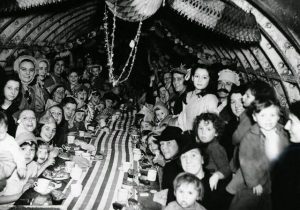 When disaster strikes, and homes are in ruin, people try to come together to help return a sense of normalcy to the people affected by the disaster. Disasters happen quickly, and the devastation is often heavy. It is a difficult thing to help people heal. While one disaster or event is often the same as another in terms of damage, something we somehow don’t connect to that same kind of devastation, is war. I’m not sure why, but when I think of war,I picture a battle held in the middle of a vast desert, with no civilization in sight. of course, when I really think about it, I now that is not reality, but rather my mind trying to fit war into a box of civility. In reality, there is nothing civil about war. Gun shots, bombs, and land mines aren’t picky about who they hit. Soldier or civilian…all are fair game in a war. And towns…well, there is often little to nothing left after a bomb hits.
When disaster strikes, and homes are in ruin, people try to come together to help return a sense of normalcy to the people affected by the disaster. Disasters happen quickly, and the devastation is often heavy. It is a difficult thing to help people heal. While one disaster or event is often the same as another in terms of damage, something we somehow don’t connect to that same kind of devastation, is war. I’m not sure why, but when I think of war,I picture a battle held in the middle of a vast desert, with no civilization in sight. of course, when I really think about it, I now that is not reality, but rather my mind trying to fit war into a box of civility. In reality, there is nothing civil about war. Gun shots, bombs, and land mines aren’t picky about who they hit. Soldier or civilian…all are fair game in a war. And towns…well, there is often little to nothing left after a bomb hits.
During World War II, London was often the targets of the German Luftwaffe, and the bombs they dropped, devastated many parts of London. From September 7, 1940, London was systematically bombed by the Luftwaffe for 56 out of the following 57 days and nights, in what was called “The Blitz.” Most notable was a large daylight attack against London on September 15th. Of course, these weren’t the only bombings, and the people of London didn’t know when or if it was safe to be out of the bomb shelters. Life in London had taken on eerie gloom,as people continued to seek refuge in the bomb shelters, because that was the only safe place to be. The biggest problem was that the bomb shelters were also gloomy, boring, and generally depressing. The children probably suffered the most, because kids don’t really understand all this hatred and killing. Their world had been turned upside down…and they didn’t know why.
By the end of 1940, 24,000 civilians had been killed in the Blitz and hundreds of thousands made homeless. In November, German bombers had obliterated Coventry city center and there had been particularly fierce raids on Manchester and Liverpool in the days leading up to Christmas. The public were now mourning the loss of their loved ones on the home front and in combat, as well as praying for the 41,000 British soldiers captured on the continent, but it was the children, in my mind, who suffered the most. Their childlike innocence was completely destroyed, along with their homes. Their parents, and other adults made the decision to change their little world, even if it was only for a short time. They didn’t have much, but they put together whatever they could to lift the spirits of these scared children. Christmas parties were held for the children and the shelter walls were decorated with paper chains and decorations, while amateur singing nights, discussion groups, and sewing circles were held regularly.
In order to avoid the bombs, many families spent some of the holidays in air-raid shelters and other places of refuge. They decked out their temporary homes with makeshift decorations…and very short Christmas trees because of the height of the shelters. Even if gas or electricity was available, Christmas dinner would have still been an amazing feat, because turkey was so expensive. Most people made do with other cuts of meat, which were still expensive. A family of four’s weekly meat ration probably wouldn’t even cover the cost of a small chicken. One alternative was home-raised chickens or rabbits, much to the shock of young children who often regarded them as pets. Home-grown vegetables and chutneys would have also made the table. Rations were 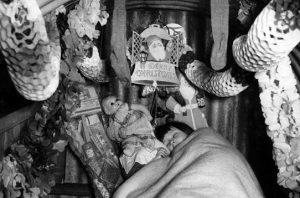 scrimped and saved including ham, bacon, butter, suet, and margarine. The tea and sugar rations were increased in the week before Christmas. Very little fruit was imported and nuts were very costly. Consequently, cooks had to improvise Christmas cakes and puddings devoid of dried fruit and marzipan, using instead sponge or other unlikely ingredients. Alcohol was available but, horribly expensive. And there would be no after-dinner French cheeses or brandy due to the German occupation. It was a poor Christmas party in comparison to those in the past, but it served to remind all the people that Christmas is more about the blessings in life, than it is about the things we are given.
scrimped and saved including ham, bacon, butter, suet, and margarine. The tea and sugar rations were increased in the week before Christmas. Very little fruit was imported and nuts were very costly. Consequently, cooks had to improvise Christmas cakes and puddings devoid of dried fruit and marzipan, using instead sponge or other unlikely ingredients. Alcohol was available but, horribly expensive. And there would be no after-dinner French cheeses or brandy due to the German occupation. It was a poor Christmas party in comparison to those in the past, but it served to remind all the people that Christmas is more about the blessings in life, than it is about the things we are given.

